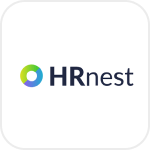
- Overview
- Configuration
HRnest
Integrate HRnest with ADManager Plus to automate employee management
The HRnest platform helps businesses manage employee records, payroll, attendance, and more. It is designed to support businesses in efficiently managing HR operations, ensuring a smooth and streamlined workflow from recruitment to retirement.
Integrating HRnest with ADManager Plus allows organizations to automate user provisioning and maintain consistent employee data across HR and IT systems. This integration ensures that the employee lifecycle is managed efficiently, with reduced manual intervention and a minimized risk of errors.
Automate user provisioning
Reduce the time and effort required for user onboarding, ensuring that employees have immediate access to the resources they need by automating user creation and assign necessary permissions across Active Directory (AD), Exchange, Microsoft 365, and other enterprise applications when new employee records are added to HRnest.
Effective offboarding
Automate the secure and compliant deactivation of user accounts and revocation of permissions across AD, Exchange, Microsoft 365, and other integrated enterprise applications when employee records are removed or marked for termination in HRnest.
How to integrate ADManager Plus and HRNest
Pre-requisites
- HRnest uses basic authentication credentials to authorize API request
- Authentication credentials required: Username, password, and subdomain
Privileges
To import users (Inbound action): Ensure the account used for authentication has permission to read all user accounts.
To perform any action or query in HRnest (Outbound Action): Ensure the account used for authentication has permission to perform the desired action.
Note: ADManager Plus comes with a pre-configured set of APIs that help perform basic actions with the integration. If the action could not be performed, please gather the necessary API details from HRnest API documentation to configure under inbound or outbound webhooks to perform them.Authorization configuration
- Log in to ADManager Plus and navigate to the Automation tab.
- In the left pane, under Configuration, click Application Integrations.
- Under Enterprise Applications, click HRnest.
- Toggle the Enable HRnest Integration button on.
- In the HRnest Configuration page, click Authorization.
- Enter the authentication credentials.
- Click Configure
Inbound webhook configuration
Inbound webhook enables you to fetch user data from HRnest to ADManager Plus. The attribute mapping configured in this section can be selected as the data source during automation configuration to perform the desired action on the list of users received from the API response. To configure an inbound webhook for HRnest:
- Under Inbound Webhook, click HRnest Endpoint Configuration.
-
In the Endpoint Configuration tab, an endpoint, HRnest USERS ENDPOINT, comes pre-configured with an Endpoint URL, API Method, Headers, and Parameters fields to fetch user accounts from HRnest. To use this pre-configured endpoint, replace {subdomain} with the domain name of your HRnest instance in the Endpoint URL field. If you would like to use a new endpoint to import users, you can configure one using the + Add API endpoint button and filling in the required fields as per HRnest's API references. Click here to learn how.
Note:
- The API key value pair is pre-configured as a header for authenticating API requests as configured during Authorization Configuration.
- Macros: You can add macros to your endpoint configuration to dynamically change it as per your requirement using the macro chooser component.
- Refer to HRnest's API references and configure additional headers and parameters, if required
-
Once done, click Test & Save. A response window will display all the requested parameters that can be fetched using the API call. Click Proceed.
Note:
- Refer to HRnest's API references to know the Parameters that must be configured to fetch only specific parameters.
- You can configure multiple endpoints for HRnest using the + Add API endpoint button. Click here to learn how.
-
Click Data Source - LDAP Attribute Mapping to match endpoints and to map AD LDAP attributes with the respective attributes in HRnest.
Note: ADManager Plus also lets you customize the attribute format from HRnest. -
Click + Add New Configuration and perform the following:
- Enter the Configuration Name and Description and select the Automation Category from the drop-down menu.
-
In the Select Endpoint field, select the desired endpoint and a Primary Key that is unique to a user (e.g. employeeIdentifier).
Note: When multiple endpoints are configured, this attribute must hold the same value in all the endpoints. - In the Attribute Mapping field, select the attribute from the LDAP Attribute Name drop-down menu and map it with the respective column in HRnest.
- If you would like to create a new custom format for this, click Mapping Attribute.
- Click Save.
Outbound webhook configuration
Outbound webhooks enable you to update the changes made in AD using ADManager Plus to HRnest or fetch or forward required details from HRnest and synchronize them with AD. To configure an outbound webhook for HRnest:
- Under Outbound Webhook, click HRnest Webhook Configuration.
- Click + Add Webhook.
- Enter a name and description for this webhook.
- Decide on the action that has to be performed and refer to HRnest's API references for the API details, such as the URL, headers, parameters, and other requirements that will be needed.
- Select the HTTP method that will enable you to perform the desired action on the endpoint from the drop-down menu.
- Enter the endpoint URL.
- Configure the Headers, Parameters, and Message Type in the appropriate format based on the API call that you would like to perform.
- Click Test and Save.
- A pop-up window will then display a list of AD users and groups to test the configured API call. Select the desired user or group over which this API request has to be tested and click OK. This will make a real-time call to the endpoint URL, and the selected objects will be modified as per the configuration.
- The webhook response and request details will then be displayed. Verify them for the expected API behavior and click Save.